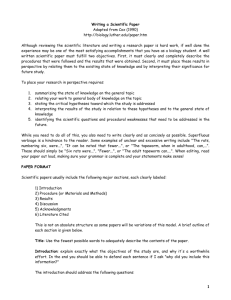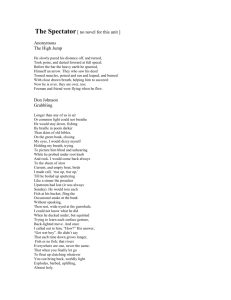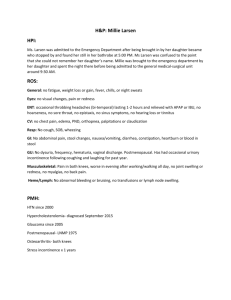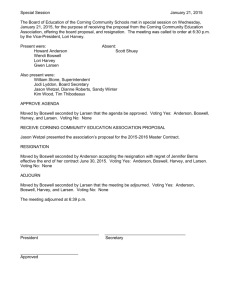essay
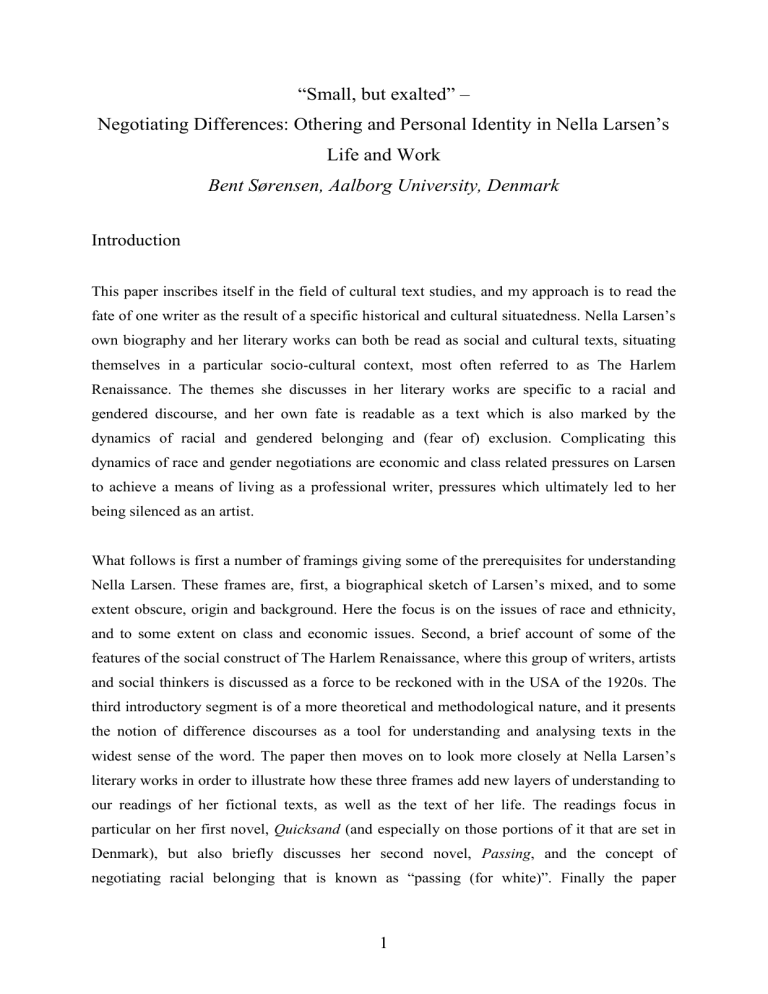
“Small, but exalted” –
Negotiating Differences: Othering and Personal Identity in Nella Larsen’s
Life and Work
Bent Sørensen, Aalborg University, Denmark
Introduction
This paper inscribes itself in the field of cultural text studies, and my approach is to read the fate of one writer as the result of a specific historical and cultural situatedness. Nella Larsen’s own biography and her literary works can both be read as social and cultural texts, situating themselves in a particular socio-cultural context, most often referred to as The Harlem
Renaissance. The themes she discusses in her literary works are specific to a racial and gendered discourse, and her own fate is readable as a text which is also marked by the dynamics of racial and gendered belonging and (fear of) exclusion. Complicating this dynamics of race and gender negotiations are economic and class related pressures on Larsen to achieve a means of living as a professional writer, pressures which ultimately led to her being silenced as an artist.
What follows is first a number of framings giving some of the prerequisites for understanding
Nella Larsen. These frames are, first, a biographical sketch of Larsen’s mixed, and to some extent obscure, origin and background. Here the focus is on the issues of race and ethnicity, and to some extent on class and economic issues. Second, a brief account of some of the features of the social construct of The Harlem Renaissance, where this group of writers, artists and social thinkers is discussed as a force to be reckoned with in the USA of the 1920s. The third introductory segment is of a more theoretical and methodological nature, and it presents the notion of difference discourses as a tool for understanding and analysing texts in the widest sense of the word. The paper then moves on to look more closely at Nella Larsen’s literary works in order to illustrate how these three frames add new layers of understanding to our readings of her fictional texts, as well as the text of her life. The readings focus in particular on her first novel, Quicksand (and especially on those portions of it that are set in
Denmark), but also briefly discusses her second novel, Passing , and the concept of negotiating racial belonging that is known as “passing (for white)”. Finally the paper
1
discusses how Nella Larsen lost her foothold in the socio-cultural group of her choice, and how she was effectively ostracised from this position of belonging or cultural sanctuary.
Biography
Nella Larsen’s biography is still not fully clarified. Despite the exhaustive work by Thadious
M. Davis in her 1994 biography of Larsen, there are still areas of her life that are uncharted and obscure. (The work of George Hutchinson, for instance takes issue with several of Davis’ conclusions.) Some of these obscurities are deliberately created by Larsen herself or by her parents and other family members, some are unintentional in the sense that they are due to lack of sources or corruption of source material over the several decades that have passed since Larsen’s death. As my main topic in this paper is the figuration of belonging and the limits of personal identity, the issues of greatest immediate interest are those of roots, heritage and race. In Larsen’s case it is necessary to distinguish as sharply as possible between her own manufactured accounts of her origins and heritage, those stories created and disseminated by her relatives and friends, and those that are a matter of public (and to some extent verifiable) record. What remains after all three types of accounts are collated can be seen to be Larsen’s mixture of heritages: West Indian, Danish, and African-American. What also remains clear is that she ultimately felt no real sense of either exiled or native belonging to any one of these heritages.
At birth Nella Larsen was named neither Nella, nor Larsen. In fact, neither of her parents went by the name Larsen, either. According to Davis, the child was “born Nellie Walker, on April
13, 1891, in Chicago” (Davis, 1994:3), registered at birth as ‘coloured’, and listed as the child of Peter Walker and Mary Hanson Walker. These names indicate a Danish – or at least
Scandinavian – belonging on the mother’s side, but none on the father’s. Baby Nellie’s status as ‘coloured’ is most likely due to a genetic contribution from Walker’s side. A few years later, however, Peter Walker changed his name to Larson (or Larsen), which indicates a
Scandinavian heritage on his side of the family as well. The name change seems to coincide with Walker/Larsen’s rise in employment status, namely his getting a job as a tram conductor, which positions at the time were reserved for ‘whites’ only (30). One might therefore speculate that Walker was passing for white, and conveniently backed his claim of racial
(white) identity up with a Scandinavian sounding name. Therefore Davis further speculates that the presence of a coloured child in a now, seemingly, all-white family was an
2
inconvenience and potentially a liability in terms of financial opportunities. Nellie was then perhaps sent away to an institution to be raised outside the family unit. She certainly did not figure in the census rosters for a number of years as belonging to the Larsen household, unlike a later child (Anna) born to the couple, who was listed as ‘white’ and as the household’s sole child.
These ‘facts’ are all puzzled out by meticulous archive research by Davis, but remain curiously gappy. The most obvious lack is that there are no extant photos of any of the family members, neither of the parents nor any of their two children. The earliest photographs of
Nella reproduced in Davis’ book are from her high school year (1908) and her time at nursing school (1915). These pictures, as all later photos of Larsen, show an African-American woman whose skin appears too dark for her to be able to pass as white in most contexts.
While there thus is reason to believe in Davis’ claim that Nella may have been sent off by her family because of her skin colour, there are no actual records of where she might have spent her missing years, and the theory remains speculative. However, Nella Larsen herself has greatly contributed to the confusion about her early years, partly by giving a – to say the least
– sketchy account of her childhood (actually altering her birth year to make herself two years younger), and partly by publicly putting out several mutually conflicting stories to ‘explain’ her roots and heritage.
According to one of these stories, Larsen claims a Danish West Indian heritage for her father, suggesting that he was a light skinned Negro from the Caribbean island of St. Thomas (now part of the Virgin Islands), and that her mother was a Danish immigrant. In other statements she claims an even ‘whiter’ heritage for her father by leaving out the reference to his colour, and adding “all his people live in Denmark”, thus perhaps suggesting that these relations were white enough to pass, even in a white mono-culture such as Denmark in the early part of the
20 th
century. (See Davis, 1994:26 for these references). None of these claims can now be verified, and Davis has found no record of Danish relatives of Walker/Larsen. Nella Larsen also liked to occasionally claim that she herself was born in the Virgin Islands and raised in the jungle. Several historians of the Harlem Renaissance have accepted as factual these stories, which Nella Larsen apparently intended as joking entertainments invented to pamper people who were eager for exotic tales, and scholars have thus perpetuated these errors by including them in their articles and books.
3
Another of Larsen’s claims, which remains unverified for the time being, is that as a young person she visited Denmark and spent time with her mother’s relatives. This would explain her knowledge of the geography of Copenhagen and of Danish language and customs, which figure prominently in several chapters of her novel Quicksand .
If that book is read autobiographically, it may also be argued that Larsen drew upon her factual knowledge and used her experience of life in her actual family in her descriptions of life in the fictive Dahl family. There are few independent sources that can confirm Larsen’s visit to Denmark, but several of her earliest publications describe Danish games and riddles that Larsen seems to have had first hand knowledge of. If, however, her mother indeed was Danish by birth, Nella could also conceivably have learned these things as a child at home in Chicago.
Larsen also claimed to have at least reading competence in Danish, and was paid to read a
Danish novel her publishers were considering for translation. However, the actual snippets of
Danish in Quicksand seem slightly odd to a native speaker of Danish, and contain spelling mistakes (“frøkken” for “frøken” (Miss), “Amielenborg Palace” for “Amalienborg Palace”, etc.). As there is no record of Larsen having bought a ticket for an Atlantic passage, nor any record of her having studied at the University of Copenhagen, as she claimed to have, the extent of her actual connections to Denmark remains unclear.
Thus, with all the conflicting stories put about by Larsen herself, and the lack of primary source evidence, such as interviews with her family in the USA or Denmark, little is known with any certainty about Larsen’s life before she entered high school and eventually went on to nursing school. These events, in contrast, are amply documented by her school records. It was during her adolescence and early youth that she finally changed her first name to Nella, after experimenting with several spellings, including “Nellye”. In this period she also established the spelling “Larsen” of her last name, and she consistently used the Larsen name for the rest of her life, although often in combination with her married name. In 1919 she married a research physicist, Elmer Imes, thus creating for herself some financial security and a place in the black middle class as long as that marriage lasted. The marriage was in many ways a prerequisite for Larsen’s writing career, and coincided in time with the very brief span of years during which Larsen actually considered herself an author and was able to function as one. After an acrimonious divorce from Imes in 1933, Nella Larsen was left to fend for herself, and she spent the rest of her life working as a nurse.
4
However, marriage and financial security were not the only prerequisites for Larsen’s artistic life. Without a cultural and intellectual environment into which she could fit, she might never have become a published writer. Such an environment was in place in New York City in the
1920s, namely the so-called Harlem Renaissance. The Renaissance was not only a rebirth of
African-American culture in the freer socio-cultural surroundings of New York’s black neighbourhood, but also a personal rebirth for writers such as Nella Larsen.
Harlem Renaissance
As a writer Larsen found a possible peerage group to understand herself through – The
Harlem Renaissance. The label ‘renaissance’ is one of several that can be given to a historically situated creative and cultural circle, group or movement (‘generation’ or ‘school’ are others). The study of such groups as productive and receptive bodies is different from and more complex than the study of individual authors. One recent example of such a study is the book The Harlem Renaissance: Hub of African-American Culture, 1920 – 1930 by Steven
Watson, who quotes W.E.B. Du Bois, “the eminent African American intellectual”, as having said: “The history of the world is the history not of individuals, but of groups.” (Watson
1995:ix) Watson’s book, while introductory in nature and occasionally prone to errors, is a good example of the interdisciplinary scope required in cultural text studies.
The other part of the label “Harlem Renaissance” of course refers to the geographical location of this “hub”, namely the predominantly African American populated part of New York City,
Harlem. This is significant for several reasons. First, Harlem was (and is) a very small geographical entity, but one closely connected with the rest of the world’s greatest metropolis,
NYC. Thus Harlem offered both intimacy and sanctuary for its racially uniform inhabitants, and an open connection to the white dominated world of patrons, publishers and people with almost unlimited economic resources. Second, the northernness of Harlem should be emphasised. New York, Illinois and other Northern states offered a goal for internal migration of the African-American population in the early decades of the 20 th
century, primarily due to the presence of large cities with employment opportunities in these states, but also due to more liberal race legislation and integration practices in these states, compared to the
American South.
5
For a brief time, roughly coinciding with the decade between the end of WW I and the Wall
Street crash of 1929, Harlem was a promised land of opportunity of all kinds for black
Americans and immigrants from other parts of the world, who created a large number of ethnic presences in the City. For artists and writers the time was right for the creation of a cultural circle of importance – a platform for the publication and dissemination of both art products (books, plays, pictorial art etc.) and manifestos of cultural politics (for instance concerning racial education and ‘uplift’).
In this climate, writers such as Claude McKay (a West Indian immigrant), Countee Cullen
(who may have migrated from the South, but who obscured his origins like many of his peers), and Langston Hughes (born in Missouri) wrote, published and socialised. All three were poets, first and foremost, although Hughes wrote in all genres and in terms of publications is the most important of all Renaissance writers. Here they found financial and artistic potential which they negotiated into literary careers of some importance. Intellectual figures such as Du Bois and Alain Locke used these opportunities to create a debate on racial destiny vs. education and uplift for African-Americans. Patrons of the arts virtually adopted black writers and supported their careers financially and by creating publishing contacts.
The number of male writers and artists far exceeded the number of women involved in the renaissance, but perhaps the most enduring figure of all the people associated with the
Renaissance was a woman. Her name was Zora Neale Hurston (born in Florida, but trained and educated in New York City as Barnard College’s only black student at the time), and she has recently been the centre of attention for academics and creative writers alike – not least thanks to the work of reinstatement into the literary canon, done on her behalf by best-selling
African-American novelist Alice Walker. Apart from Hurston only two female novelists are remembered today as integral to the Renaissance, Nella Larsen and Jessie Faucet.
It was in this hotbed of creativity and intellectual challenges that Larsen found the opportunity to fashion herself as a writer. There were outlets for short non-fiction pieces and stories in the numerous magazines in circulation at the time, and ultimately mainstream publishing houses such as Alfred Knopf were open to what was then called ‘Negro’ literature and started publishing novels by the Renaissance writers. This would not have happened without the extensive networking going on under the Renaissance label, which involved a complex structure of patronage, friendships, movements and parties, social and cultural functions
6
(parties in another sense of the word!), awards and prizes of many kinds – or in short a whole critical and cultural public, consumed with an interest in African-American issues.
Though the Renaissance had a short life span in term of years, and stopped being a thriving cultural force of magnitude, when the economic climate took a drastic downturn after 1929, its lasting importance lies in the legacy of texts produced in this circle, and the issues that were raised and dramatised by the texts and lives of its writers, which continued to inform intellectual debates in the USA well into the 1970s.
Difference discourses
As a tool for situating the concentric circles of topics of interest to us in this essay: Nella
Larsen’s work, her life, and her participation in a socio-cultural group such as the Harlem
Renaissance, we need a general theory that conceptualises all these dimensions as social texts.
Such a theory is set forth in brief terms in the following section.
Formulating the concept of difference discourses marks an attempt to come to terms with a dynamic culture composed of many layers of social text. A dynamic culture, with a multitude of discourse carrying media becoming available, and with more people than ever before having some form of reading competence, requires a dynamic theory of reading such discourses, or social texts. Reading competence should here be understood not merely in the narrow sense of literacy, but in the wide sense of having the tools to engage in various reading protocols for various genres and media – ranging from print media, such as novels, to movies, cartoons, music products, etc.
We therefore need to create a dynamic theory which pays both attention to genetic as well as reception aspects of the textual phenomena, and attention to the historical situatedness of these phenomena. The theory of difference discourses is an attempt at creating such a dynamic, yet general, theory, and a starting point for the discussion of it is definitions of the two parts of the label for the theory: ‘difference’ and ‘discourses'.
The first label element is ‘discourses’. It is by now a commonplace to talk about an extended concept of text, meaning text in the semiotic sense. Semiotics (or the theory and science of
7
signs) is in fact the only suitable reading method that cuts across all genres to the understanding that all combinations of signs are texts, in that they carry signification, whether this combination of signs is created intentionally or not. All combinations of signs can be read, and everything can become signs, and thus readable. It does not matter, as such, whether the signs composing the text in question are graphic signs, moving or still images, words, letters etc.
Turning now to the other label element: ‘Differences’ are here to be understood as modes of explanations for phenomena and events. These are invariably structured as pairs of oppositions in the ‘cultural’ realm, expressed in figures of speech, or narrative structures.
These ‘differences’ are traditionally perceived as either biological givens (man vs. woman, for instance) or socially derived structures (working class vs. middle class, for instance). They are believed to constitute us as subjects and to explain our being in the world. In postmodernity we have gradually come to realise that all these differences are and always have been language constructs as well as or, some would say, rather than givens, and therefore all differences are negotiable in communicative situations.
A very limited catalogue of large, signification-carrying differences can be generated, consisting of the following six discourse differences: age, sex, race, class, nation, and religion. There may be periods where terms such as ‘religion’, ‘nation’ and ‘class’ are not applicable, but for the period of the 20 th
century we are concerned with, all these are useable as cover terms. ‘Class’, for all discourse about socially constituted differences; ‘nation’, as covering all in- group, out-group figurations with relation to topological origin, whereabouts or belonging; ‘religion’, as covering all issues of spirituality, belief and destiny. The supposedly biologically determined differences take various other identities when discursively placed: for instance, ‘sex’ differences are usually discoursed about as gender differences, where ‘gender’ is taken to mean culturally and communicatively significant aspects of our sexuality, and ‘race’ differences are often nuanced into discourse about
‘ethnicity’.
Here it should be restated as strongly as possible that all the differences are negotiable, even the supposedly biologically determined ones. These should rather be seen to just have a biological origin that can be used as the base for historicising and situating them communicatively, i.e. negotiating them in discourse. ‘Sex’ is, for instance, not an unalterable absolute –
8
as witnessed by transsexual and transgendered identities, and race is not an absolute, clear cut identity – as witnessed by the notion of ‘passing (for white)’.
It is now possible to claim that it is exactly when the negotiation of differences takes place that the differences become readable as discursive phenomena and that they generate social texts. All these difference discourses/social texts are readable as embodying narratives of a subject (an ‘I’) and an ‘Other’. The textual representation of ‘I’ and ‘The Other’ and the interrelations between these as textual instances may contain any blend of the above tropes, but in various historical periods and climates one or more difference discourses will be dominant, whereas others are marginalised or potentially excluded from discursivity as ‘givens’.
This leads us to introduce the concept of discursive field as an applicable metaphor for this dynamic. The notion of field allows for several difference discourses to co-exist simultaneously, yet also allows for some of them to be more centrally placed vis-à-vis than others. Here the concept of dominant versus marginalized discourses is useful.
Any one text can, of course, act and inscribe itself in a number of the available difference discourses. One overlap might be the complexities of a novel both about race and gender, as in the case of Nella Larsen’s works. In such a case a struggle for dominance of one discourse over the other(s) will ensue, and the outcome of this struggle is ultimately determined by the climate of difference discourses in the larger public sphere, which will decide which discourse any given book/object becomes inscribed in. Therefore Larsen’s books can (and have been) read variously as African-American literature and/or as proto-feminist literature. None of these reading protocols are inherently wrong, but merely reduce the complexities of the novels in question to a larger degree than necessary. Such a reductionism may be avoided when the difference discourse theory is applied.
Double othering: race and gender biases
The operative differences in Nella Larsen’s case are primarily the double minority position of race and gender: she was a black woman. She was both othered by the dominantly white literary establishment, and by the male dominated black Renaissance (there are of course exceptions to this general statement, for instance the white patron of the arts and mentor of many of the Renaissance writers, Carl Van Vechten, who remained a steadfast friend and
9
supporter of Larsen, until she herself broke off contact with him). Class played a smaller but important role, because of the pressures of financial dependence that the other minority positions forced her to negotiate. Larsen therefore developed a consistent behaviour of alternately ‘begging’ and ‘bullying’ in order to gain recognition and/or support that further alienated her from potential supporters. This dynamics of double othering, always with the threat and fear of social deroute and poverty lurking in the background were not only real-life pressures Larsen had to negotiate, but, as we shall see in the following analyses, also surfaced as constant thematic complexes in her literary works.
Quicksand
Larsen’s first novel (published 1928) is a partly autobiographical account in the shape of a female Bildungsroman . The heroine of Quicksand , Helga Crane, undertakes a journey of character formation. She moves from the rural south, where she is a teacher at an institution for blacks, seems to find a temporary home in Harlem, until disgust with her own race makes her flee Harlem when a magical solution presents itself – namely going to Copenhagen. Her sojourn in Denmark forms the centrepiece of the novel, but ultimately she has to leave
Denmark, because she does not conform to the social norms: marriage being the expected and ultimately the only accepted behaviour of a woman. Thereupon she travels back to Harlem
(“homesick, not for America, but for Negroes”(Larsen, 1986:92)), and ultimately back to the rural south, where, ironically, she ends up in the worst case scenario of all her fears, as a wife doomed to endless child births, living in a totally unstimulating, all black, environment, waiting for death while her spirit has already died. She is thus oppressed on behalf of race in the US, oppressed on behalf of gender in Denmark, and always in the background lurks the threat of social deroute, if she deviates from the narrow path of normative behaviour for a coloured woman.
Helga Crane is offered a number of opportunities for happiness, but discards them one by one
(usually they present themselves as marriage proposals), as she is restless and unable to accept any form of compromise. She is also tainted by her non-belonging to two races and cultures, the African-American and the Danish, i.e. white culture. She alternates between hatred and disgust of her blackness, and a superficial pride in being exotic among the pale
Danes. Ultimately she realises that even in Denmark she is being othered by being turned into a show-piece which her Danish relatives, the Dahls, use to create a better platform for their
10
own position in society. This is symbolically expressed in the novel through several metaphors for bondage and slavery. She is being put on display in many ways in Denmark, not least through the way she is dressed and accessorised by her aunt. She is given bracelets that are the figurative equivalent of shackles hinting at a slavery position. She is dressed very colourfully and sexually provocatively, which is figured as a way of prostituting her.
Prostitution is here also linked to slavery and seen as the only way in which Helga as an inferior other can achieve a form of conditional freedom.
Trading a life in the utter poverty of slavery for a life of relative financial ease as a prostitute or a wife is regarded as the best option for Crane by the Dahls, who thus symbolically function as her pimps. Ultimately she becomes a model for a painter who does a portrait of her, showing her as a bad, wicked person, yet who cannot resist propositioning her, first to be his mistress, and when she refuses that, then to be his wife. The representation of her in the portrait as a temptress and a whore is emblematic of the way that she is seen by the men of the
Danish upper middle class circles which the Dahls move in. “A disgusting sensual creature with her features” (89), is how she herself thinks of the portrait, denying that it reveals her true self. We as readers are here invited to reflect on whether Helga at this point in her development has a true image of herself, or whether the gaze that others her as a sensual creature in fact sees her more truly than herself.
When she also refuses the painter’s offer of marriage she is punished by the Dahls, who find her ungrateful and ultimately literally take her off the market and urge her to go back to
America and try her fortunes there. This means a sacrifice of her sanctuary in an apparently racially unbiased society such as Denmark, but it also means that she is back in an economic situation where she is forced to be self-dependent and -sufficient. As it turns out, this initiates the slide downward in social and financial terms that ends with her forced marriage to a preacher from the rural South.
While Helga left Harlem for Denmark with “no regret” (63), and after two years leaves
Denmark for Harlem “with infinite regret” (93), the reader realises that Copenhagen has been nothing but a magical interlude in her life, and that the problems of racism, misogyny and class pressures have haunted Helga with equal force in the two cities. Thus what she has tried to escape from in Denmark is waiting for her back in America, and the slavery is only postponed, not avoided as her fate. Denmark is not the promised land it appeared to Helga to
11
be, and her fond childhood memories of Denmark from her first visit there, as a country with
“no Negroes, no problems, no prejudice” (55) prove false. These ironies are made very plain when we remember Helga’s first impressions of Copenhagen: “how odd and how different to
America” (72), but realise in retrospect that it is only on the surface that Denmark is different and that the underlying social pressures are really the same for a coloured woman no matter what nation she lives in. This can be read as the strong feminist and racial message that
Larsen has created for the reader of Quicksand
, and unlike Larsen’s contemporary readers we should not let the tragic figuration of the mulatto heroine’s life expressed in the last chapters of the novel blur this message.
Passing
In her second novel (published 1929) Nella Larsen explores different strategies of escaping the double othering of race and gender through the strategy of passing (for white) – but similarly to the first novel Passing also ends up with the heroine as a victim of envy and hatred.
Irene Redfield and Clare Kendry are the two female main characters, and of the two, Clare represents the type of woman who is willing to sacrifice everything for a chance at personal and social uplift. To achieve her aims Clare exploits the fact that her skin is white enough for her to be able to pass, and this becomes the key to a comfortable middle class life. The price she first must pay is that her new husband, who is unaware of her ‘former’ life as a coloured person, is a bigot and a racist whose favourite pet name for his wife is “Nig”. The irony of this situation is not lost on any of the characters in the book, nor on the reader. Irene, on the other hand, feels trapped in her life, but comforts herself that at least she remains true to her racial destiny as a woman of colour.
In the culmination of the novel, Clare dies as a result of a fall from a high window during a party. It is suggested strongly that Irene has pushed her to her death, but none of other characters actually seem to have seen the events unfold, so Irene will not be punished by law for her act. Of course she will then have to live silently with her guilt, which is almost as intolerable an alternative, as it involves a sacrifice of her personal integrity. Irene chooses the lie, and she justifies this to herself as necessary for the protection of her family, and particularly her husband’s reputation. However, she also initially justifies the murder of Clare,
12
paradoxically, as an act of protection of Clare: “She couldn’t have Clare Kendry cast aside by
Bellew [her bigoted husband]” (Larsen, 1986:239), but in the very next sentence (rendering
Irene’s thoughts, or internal monologue) the real motive slips through: “She couldn’t have her free” (239).
Thus, it is really jealousy of Clare’s self-realisation that motivates Irene’s hatred and her deed.
This goes to the core of the problematic of passing (and Passing ): Passing is tempting, because it holds out the lure of uplift, but also dangerous because people who are unable to pass will begrudge you the opportunity. Larsen was, of course, herself painfully aware of the emotions of one who could never pass for white, but rather than identifying her with the murderous Irene, it would perhaps do Larsen’s imaginative craft more justice to suggest that she, in her novel, shows the empowered woman, Clare Kendry, as the real heroine, and Irene as the victim for whom we should not feel pity, but rather outrage that she is permitted to extinguish Clare’s freedom. (Clare is in fact several times figured metaphorically as a flame, burning (too) brightly: “One moment Clare had been there, a vital glowing thing, like a flame of red and gold. The next she was gone” (239)).
Both Larsen’s novels were well received by critics and reading public alike, but criticised for their endings, casting female characters as victims. None of her contemporaries seems to have considered the possibility of deliberate feminist didacticism as a strategy on Larsen’s part, yet as we have seen above, the many cases of ironic narration in Quicksand and Passing make such readings plausible. Larsen’s autobiographical role as the victim of discrimination and exclusion from family because of her dark skin colour made her very well acquainted with the economies of victimhood. It is not farfetched to think that she used her novels as a vehicle to communicate the dangers of dark females accepting this victim status and relinquishing the perpetual struggle for recognition despite of otherness of appearance.
“Sanctuary” and plagiarism: recognition and backlash
In 1930, after winning a Guggenheim fellowship to research and write her third novel in
Europe, Larsen was hit by accusations of plagiarism in connection with the publication of her short story, “Sanctuary”, in the magazine Forum . Larsen’s Harlem peers quickly began circulating rumours that Nella Larsen had adapted a British short story, “Mrs. Adis” by Sheila
Kaye-Smith, and altered only a few of the incidentals of that story in her version. The main
13
change was that the 1922 British story used class as the difference on which the story hinged, whereas Larsen used race. This was particularly expressed in the dialogue, which Larsen turned into black rural dialect. Otherwise both stories featured a strong female protagonist who protects the murderer of her own son out of loyalty to her own peer group, defined in terms of either class or race. This is a strong, but rather melodramatic, plot, and one which
Larsen later, when she was forced to publicly defend herself against the accusations, claimed was a generic (black) legend told to her many times by her patients and other associates, always as having happened to them personally.
These accusations jeopardised the Guggenheim scholarship, which was supposed to be the highpoint of Larsen’s journey towards recognition as a writer, not just a black writer and a woman writer. Her psychology made her fiercely competitive in relation to other women – for example Jessie Faucet, whom Larsen considered the only other female novelist of quality, associated with the Renaissance. This competitive and at times self-promoting behaviour also galled several male intellectuals who lashed out in chauvinistic and patronising terms against her character which was seen as manipulative and mischievous. (See Davis, 1994:8) The language used in some of the private accusations against Larsen was strongly patronising and sexist. Harold Jackman, a minor Renaissance author and society gossip writer, was particularly vicious, for example writing to Countee Cullen: “Boy, that gal has used some of the identical words miss Smith uses in her Mrs . Adis , and as for the dialogue, little Nell, I’ll call her this time, has just changed it to make it colored.” (Quoted in Davis, 1994:349) Note here in particular the patronising diminutives used about Larsen (“gal” and “little Nell”), and how they are specifically gendered in contrast to the male gendering of the recipient of the letter, Cullen, implied (perhaps subconsciously, perhaps jokingly) by the exclamation “Boy”.
The accusations against Larsen of plagiarism were apparently well founded, although the scandal was somewhat abated by her article defending her writing of “Sanctuary”, also published in Forum , but the long-term consequences were unnecessarily harsh, since she never again published a work of fiction. Metaphorically speaking, this silencing of a black female author has aspects of a lynching about it, but in this case a lynching perpetrated by her own male peers who shared her race, yet othered her on the basis of her gender – perhaps further motivated by the superior craft she exhibited as a writer.
14
The Guggenheim scholarship was not retracted, and Larsen spent time in France, Spain and
North Africa researching her novel. Her progress reports to the Guggenheim foundation were guardedly positive, but in private letters it was clear that she was seriously worried about finances and the impending end of her marriage to Elmer Imes, who was cheating on her.
After her divorce from him in 1933, her days of financial independence were over, and she was unable to sustain her writing career. The manuscript of the final novel seems to have been left in care of one of her European friends, but is now apparently lost. Larsen was silenced while alive by a combination of gender jealousies, racial circumstances and social pressures.
Posthumously she has remained silenced for a long time, due to the neglect and carelessness of her friends and the forgetfulness and lack of respect from her former peers.
Conclusion
Originally, of course, the title of this paper is a quote from the novel Quicksand (Larsen,
1986:67), but the phrase “small, but exalted” can suitably serve not only as a title, but also as a springboard for the conclusion to this analysis of Larsen’s life and work, for at least the following reasons:
When Larsen’s protagonist alter ego, Helga Crane, thinks of herself through this dual metaphor, she is in the midst of re-discovering her self in a new setting. She has that same day arrived in Denmark, been well received by her Danish family and treated like visiting royalty.
The pleasure of that day is encapsulated in this ambivalent feeling of Helga’s: she is still a small person in the sense that she is not important, wealthy or well-connected, and she is alone in the world in the sense that her belonging is tenuous and uncertain. However, she has the sense that her belonging is about to be redefined and re-affirmed in a Danish context, where she will be thought of as special and unique. This singles her out and exalts her above her peers whom she has already left behind along with the other members of her race back in the USA, and she does not yet understand the perils of such high visibility as would come with the exaltedness of her position.
On the level of the author, Nella Larsen is in a sense a small writer, both because her published out-put is not large, but also because she was largely forgotten for many years. She has, however, of late become exalted because of the increased interest in her specifically, and
15
generally in unearthing African-American literary foremothers (the project of among others
Alice Walker and Tony Morrison).
Thus, the phrase “small, but exalted” serves as a connector on two analytical levels. It can be read as a metaphor that connects the issue of personal identity with issues of group belonging and identification, cf. the negotiations of the difference discourses Larsen herself and her protagonists were forced to conduct. It also serves to illuminate the efforts of us as readers and analysts of Larsen’s life (as social and cultural text) and her works, in the sense that we may conclude that the phrase adequately describes our understanding of Larsen’s textual legacy at this point in history.
Bibliography
Baker, Houston A., 1987: Modernism and the Harlem Renaissance. The University of
Chicago Press, Chicago
Balshaw, Maria, 2000: Looking for Harlem: Urban Aesthetics in African-American
Literature. Pluto Press, London & Sterling, Virginia
Davis, Thadious M., 1994: Nella Larsen: Novelist of the Harlem Renaissance – A Woman’s
Life Unveiled . Louisiana State University Press, Baton Rouge & London
Douglas, Ann, 1995: Terrible Honesty: Mongrel Manhattan in the 1920s.
The Noonday Press,
Farrar, Straus and Giroux, New York
Hutchinson, George, 1995: The Harlem Renaissance in Black and White.
Bellknap Harvard,
Cambridge, Mass.
Larsen, Nella, 1986: Quicksand and Passing . (Edited by Deborah E. McDowell) Rutgers
University Press, New Brunswick, New Jersey
Lewis, David Levering, 1979/1997: When Harlem Was in Vogue.
Penguin Books, New York,
London etc.
Watson, Steven, 1995: The Harlem Renaissance: Hub of African-American Culture, 1920-
1930 . Pantheon Books, New York



